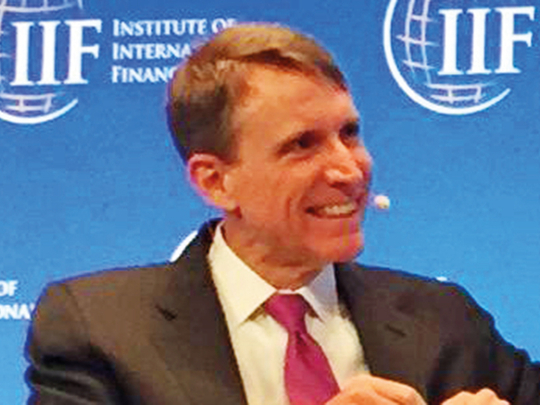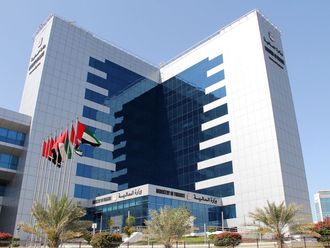
Dubai: GCC economies are on a more stable and sustainable growth trajectory following the global financial crisis and low oil prices that saw growth decelerating across the region, Timothy Adams, president and CEO of the Institute of International Finance (IIF), told Gulf News in an interview.
“Global economy is in a robust shape. Across the world there is a sense of recovery for real with growth picking up. There has been an improvement in commodity prices. The US is doing incredibly well with the unemployment levels below 4 per cent, European economic growth is picking up after a crisis-ridden decade. By and large there are lots of good stories out there,” said Adams.
Although there is a sense that the region’s business cycle is out of sync with that of the US, in addition to the fact that monetary policy tightening that is bound to increase the cost of funds could prove an economic headwind to the region, Adams believes the spillover effects from global economic recovery — ranging from improvement in energy demand, recovery of oil prices, improved prospects to trade and tourism numbers — can boost region’s economic growth.
“We are seeing a more stable and sustainable economic conditions across the GCC especially in the UAE. We may not be seeing the very high rates of growth in some of the regional economies that we saw prior to the financial crisis, but stable and sustainable is a very good place to be in 2018,” said Adams.
Risks
Cleary, the global recovery comes with risks ranging from geopolitical risk, excessive global leverage and trade tensions that could eventually develop into a trade war that could have detrimental impact on all major global economies including those in the Middle East.
Excessive leverage in the global economy is likely to pose medium-term challenges to many countries. According to the IIF, some $21 trillion (Dh77.13 trillion) was added to the global debt mountain in 2017, bringing it to an all-time high of $237 trillion.
However, with world GDP growth running above potential, the debt-to-GDP ratio continues to decline. With global financing conditions still relatively benign, the risks of such a rapid increase in the debt burden remain largely under the radar.
FX-denominated debt
In a more turbulent market environment, vulnerabilities related to debt could come into sharper focus, according to Adams. Reliance on foreign currency (FX)-denominated debt in emerging markets has continued to rise, reaching a record high of $8.3 trillion in 2017.
Although the soft dollar has been supportive, some countries with relatively high levels of FX debt burdens (Argentina and Turkey) are seeing significant downward pressure their currencies this year. IIF data shows maturing FX obligations across emerging markets total nearly $1 trillion through 2019. Countries facing significant refinancing challenges include China ($214 billion in maturing FX debt through 2019), Russia ($67 billion), Korea ($66 billion), and Brazil ($61 billion).
Spectre of trade war
A potential trade war could turn out to be a major threat to global growth.
“I do worry about trade tensions and rising protectionism and the politics around that. We are seeing that spilling over into the emerging markets. Over the past few weeks the markets have shown some concern on pricing over the trade war rhetoric,” said Adams.
Trade war rhetoric, Adams thinks, is more likely to pass without major consequences to the global economy. It is highly unlikely that the war cry will manifest into something that is much more aggressive and detrimental.
“The global banking and financial services community is not seriously concerned about it. Looking. Markets on the other hand are somewhat worried about the unpredictability of government policy and that is visible in the volatility we have been experiencing,” he said.
US trade policy under Trump administration is a clear departure from the previous three decades. However, Adams said it resembles that of Ronald Reagan era, in which Japan was the villain at the time. The era saw heavy Japan bashing that followed US-Japan negotiations, under the Structural Impediments Initiative (SSI).
The two countries were engaged in fierce bargaining over a wide range of products which eventually led to the 1985 Plaza Accord followed by the 1987 Louvre Accord that saw a significant exchange rate correction between the yen and the dollar.
“It feels more like 1980ish and I feel there is room for negotiated settlements in trade disputes between US and China,” he said.
A failure to reach negotiated settlements could lead to sweeping tariffs that could provoke retaliation, stifling US exports and raising costs for US businesses and consumers. An outright trade war could result in US manufacturers facing more expensive product components and disrupted supply chains, affecting jobs.












